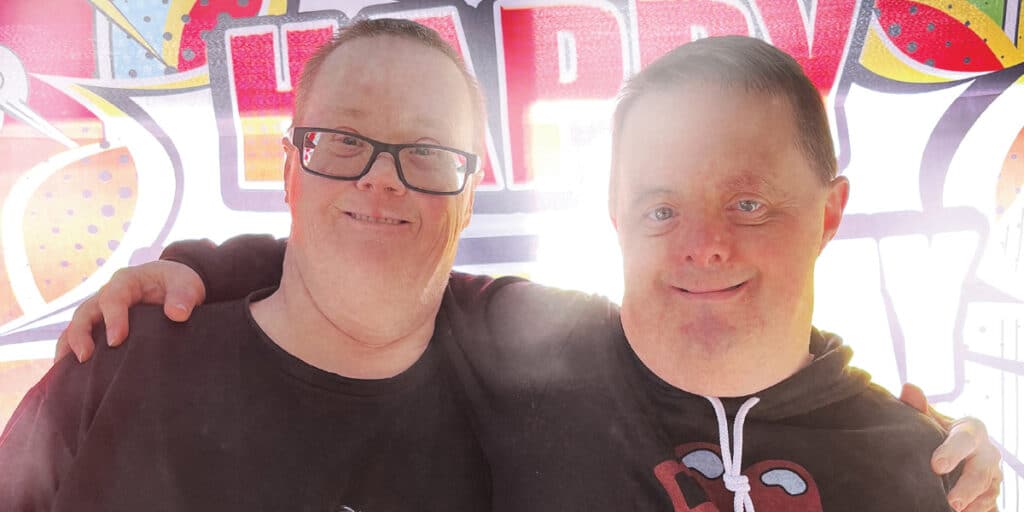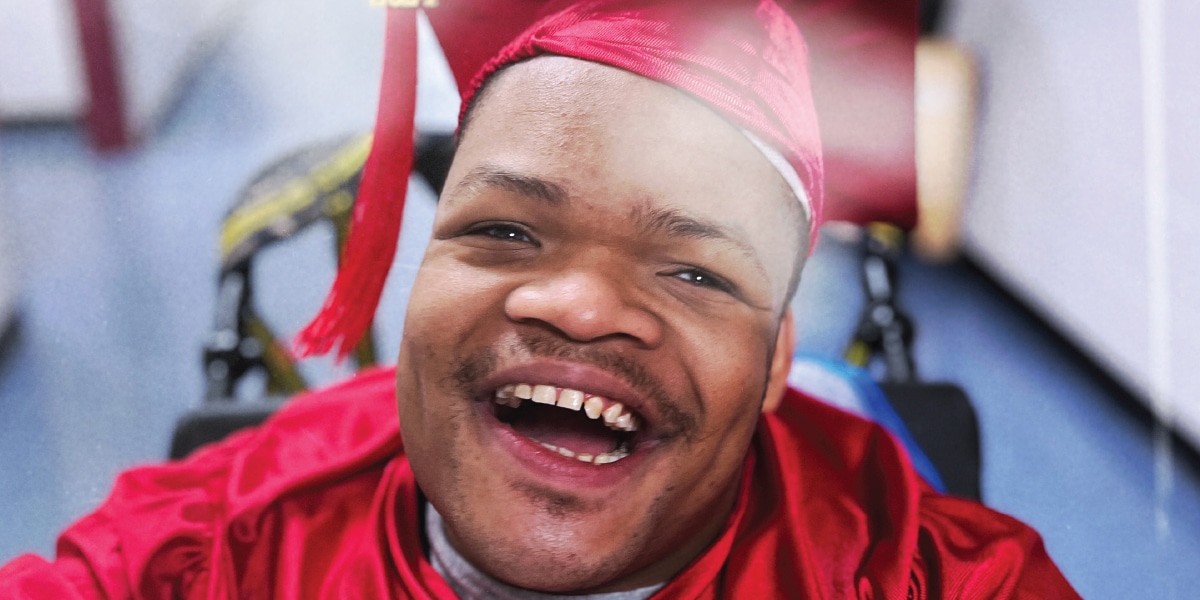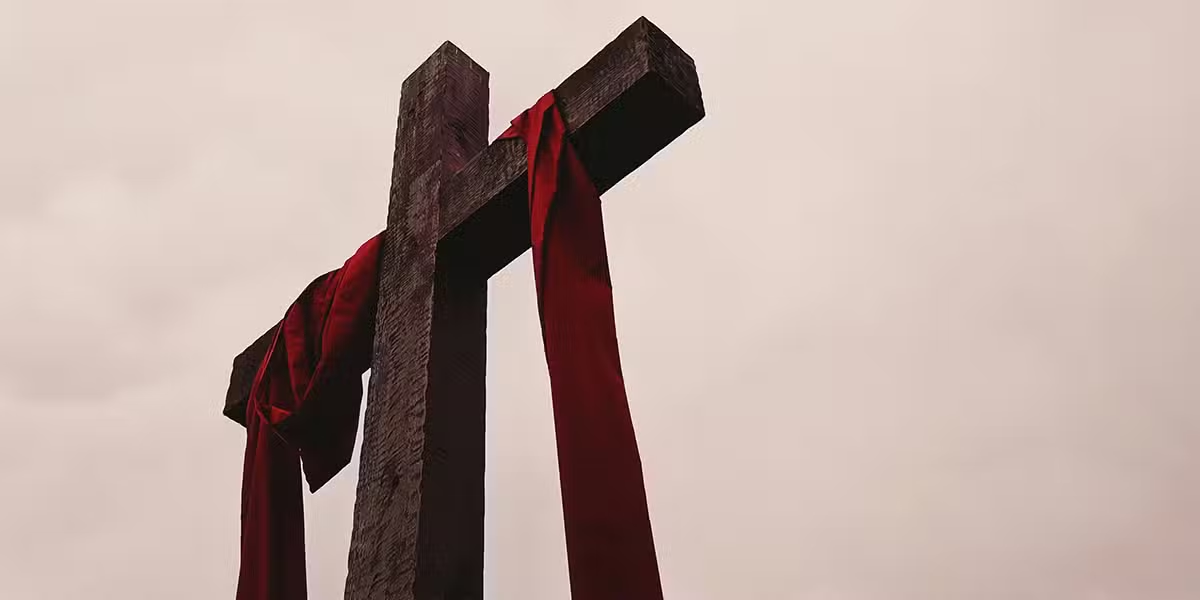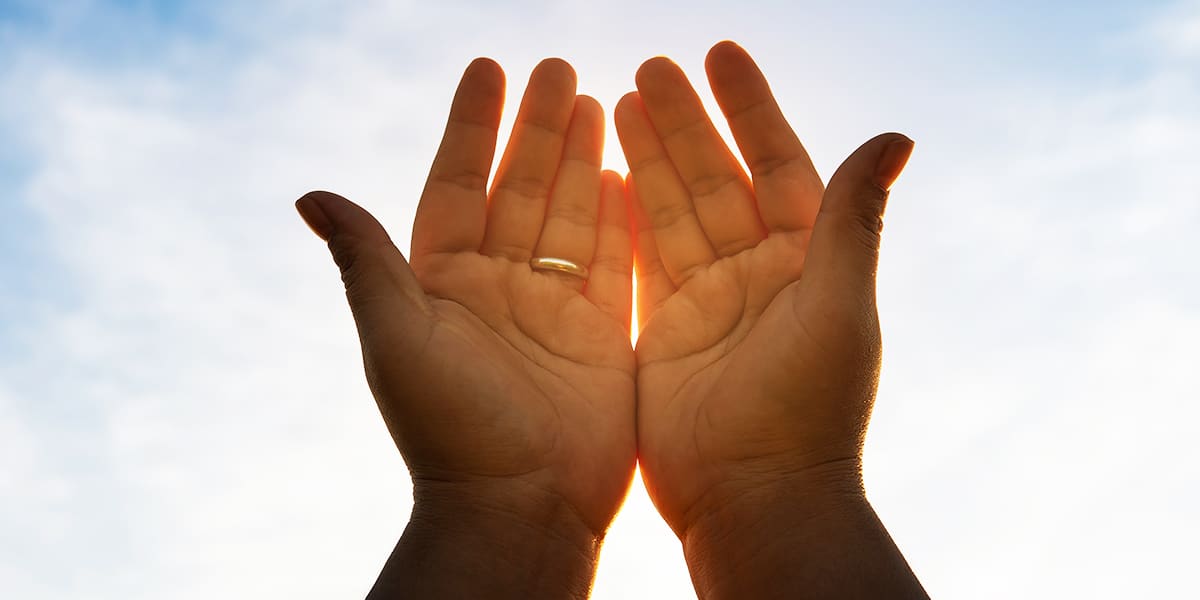Tucked away in Belmont, North Carolina, Holy Angels has not only cared for individuals with intellectual and developmental disabilities but has also transformed lives, including those of the caregivers.
If a book were written about their 70 years of service, they say it would be titled Behind the Bushes. Every day, tens of thousands of cars make their way down Charlotte’s busy Wilkinson Boulevard, past giant, whimsical, topiary letters that spell Holy Angels. What goes on behind those bushes? Few know. I live a mile away, and I didn’t know.
It was some Catholic thing, I figured, when I moved to Belmont, North Carolina. Follow the defunct trolley tracks north of Holy Angels for a mile and you’ll run into Belmont Abbey College, founded in 1876 by Benedictine monks. Follow the tracks south and you’ll end up on the far side of Holy Angels, on the grounds of the Sisters of Mercy, a convent founded in 1892. Take the tracks south a little more, and you’ll be in Belmont’s charming downtown, where shops like Bliss Gallery, Cherub’s Cafe, and the Cotton Candy Factory are run by Holy Angels and staffed with employees who have Down syndrome or other intellectual and developmental disabilities. Still I was unaware of the scope of Holy Angels until this story took me there—until I journeyed behind the bushes.
Butch, Mac, Mark, Andrew, and Bruce
Was it guilt that arose, for having two healthy children? Or worse, pity? Or worse even, bitterness toward God, toward life, toward this reality in which people are seemingly cursed with these bodies, unable to do anything on their own?
Visiting Holy Angels in Belmont can somehow be jarring, sobering, beautiful, and inspiring, all tangled in a knot around your heart. I was in Moody Place when it hit me. Communications director and former newsman Shawn Flynn had guided me around the Holy Angels campus, touring the residential buildings that house 80-plus residents between the ages of 1 and 82 with intellectual and developmental disabilities.
But in this large, open room at Moody Place were a dozen residents or so, all in wheelchairs needing constant care from one of Holy Angels’ 350 employees. We were greeted with residents’ vocalizations that I could not quite make out. The air carried the familiar scent of a place dedicated to those who need round-the-clock attention. “It takes a special person to work here,” Flynn says to me.
The needs here were more intense than at the previous building we visited, Oakcrest, where we met Butch, an 82-year-old blind, autistic, musical savant who has played piano at the White House, and where I met Mac and Mark, middle-aged men who shared with me their obsessions with Michael Jackson and the Minnesota Vikings. In that building were people capable of working at one of the nearby Holy Angels’ businesses. Not here. In came the guilt and pity and bitterness and, yes, shame. I didn’t like that my knee-jerk reaction was to see these people as fundamentally different, other, or, Lord have mercy, “less than.”
We walked up to a young man named Andrew, a 24-year resident of Holy Angels who beamed upon seeing Flynn and flexed his muscles for him. “Show me those muscles!” Flynn hyped. Andrew made a noise and somehow Flynn knew that he wanted his picture taken. We walked by another young man named Bruce, lying across strategically placed mats on the floor as he stared at the ceiling. “He’s a really good guy,” Flynn says. “He actually just graduated from our school program this year. He used his walker so he could walk to receive his certificate.”
Flynn guided me into a sensory room, where residents are led through virtual hikes in front of a large dropdown screen. Rocks and leaves are passed around for the residents to touch. Aromatherapy is infused into the room to experience the smells of nature. It dawned on me that these people whom I had seemingly pitied not only had their basic needs met but thrived in their quality of life, thanks to Holy Angels. They were happy. Holy Angels not only has living quarters for their residents, with wraparound care tailored toward each person’s needs, but they also have a hospital wing with doctors and nurses as well as classrooms staffed with professional educators. Sprinkled around campus are hot tubs for water therapy, which can be groundbreaking for those with neuromuscular disorders. Nearby was a gigantic swing set with metal platforms at each station where local high schoolers visit Holy Angels to push the residents on their swings while in their wheelchairs.
How many times had I driven by that sacred place?
Back in his office, Flynn shares with me that these beautiful people—these “holy angels” he gets to be around every day—are like a vein to his own heart, beacons of light and love.
Maria, Lorraine, and Nolan
It was at the intersection of mill life and Catholicism that Holy Angels came to be.
In 1955, a young single mother had a child named Maria. Her head was enlarged by hydrocephalus, and her arms and legs were contorted. Needing to return to work at the mill, the mother reached out to the Sisters of Mercy, a community of nuns in Belmont who had begun running a nursery to serve millworkers and their families. The sisters offered to keep Maria full-time because they felt it would be better for Maria and her mom. Holy Angels was born. Maria Morrow was 3 months old when the sisters took her in. Doctors believed she only had three to six months to live. Maria passed away in 2010 at the age of 54.
In Holy Angels’ genesis, articles by nationally syndicated Charlotte Observer columnist Kays Gary helped the word get out about these nuns who took in children with severe developmental and physical disabilities, and at one point people from all over the world began mailing envelopes filled with pocket change to support the mission. One New York couple in the 1960s heard of Holy Angels and boarded a train to Belmont, desperate for help with their 9-month-old daughter, Lorraine, who had Down syndrome. Lorraine immediately became calm and content under the care of the sisters, and the couple took it as a sign. That was 61 years ago when the Sisters of Mercy took her in. Today Lorraine remains one of the residents at Holy Angels and is seen working at their different businesses.
“She is stubborn, and we love her for it,” Flynn laughs. “If you don’t make the chicken salad right, she will let you know.”
The stories of Maria and Lorraine are reminders of the challenges families face when they have a child with severe mental or physical disabilities. Those stories continue to play out today.

Now I’m in a small meeting room on campus at Holy Angels. I’m back again, behind the bushes, looking into the eyes of a woman who has been through hell, who has endured what no parent should endure, yet wears a diamond ring on her right hand with the Holy Angels logo.
Sara Anderson told her husband something was “off” when she was pregnant with their first child in 2003. At 9 months old, Emily began having seizures that doctors were unable to get under control. Four months later, Emily passed away. “I was able to spend every single minute with Emily,” Anderson reflects. “Even though she left, she only knew love.”
Doctors believed Emily’s death was due to preterm labor, and Anderson and her husband were encouraged to keep trying for kids. Four years later, they had a boy. No seizures. But two years later, when Anderson became pregnant again, she could again tell something was off. This pregnancy mirrored Emily. In 2010, their son Nolan was born, and five weeks later he, too, began having seizures. Doctors believed he wouldn’t live beyond his first birthday. “The anger I had toward God engulfed me,” Anderson shares. “I was bitter and mad, and I was really afraid to get close to Nolan. I would feed him and make sure he was taken care of, but I didn’t want to love him, if that makes sense, because I feared I’d lose him.”
Thanks to medical advancements in the field of muscular dystrophy, the Andersons were able to get Nolan’s seizures under control. But as Nolan grew bigger, the challenges multiplied. The seizures had altered both his brain and physical development. He was bound to a wheelchair and had severe challenges with verbal communication. He needed therapy five times a week and around-the-clock care, a tall task as their family continued to grow. By then, there were four children, and Anderson was drowning.
A caseworker told her about Holy Angels. She fell in love when she toured campus. When the funding allowed Holy Angels to add two more residents, the Andersons discussed how this move could help Nolan to have the best quality of life since their attention was so divided.
Anderson looks over at Nolan, whom Flynn just wheeled into our small meeting room. He gazes at his mother. Tomorrow she’ll be back here again. The residents are going trick-or-treating through the convent as the nuns give out gifts and treats. Nolan is going to be the Grinch.
Megan
It’s no surprise that the Holy Angels logo is a heart. It took heart for the Sisters of Mercy to do what they did 70 years before, a legacy that continues to inspire Holy Angels employees in the present. “To work here, you have to have a big heart,” Flynn shares.
I’m back again, this time in a large conference room with Flynn and Holy Angels president and CEO Kerri Massey, who began working here 26 years ago as a social worker. She jokes that she has served in almost every role en route to being appointed president in 2022. But only recently has she begun to share her story.
“Acceptance is so important,” Massey shares. “I have always been so accepting of this place—it’s where my heart is—but when it affected me directly, I wasn’t so accepting of it.”
Massey had been working at Holy Angels for five years when her only child, Megan, was born. Considering Massey had a healthy pregnancy, it was a shock when doctors shared that Megan might have Down syndrome. Genetic testing, however, came back negative, and it was discovered that Megan had external hydrocephalus, which was expected to resolve itself in time. It didn’t. Megan wasn’t growing and her cognitive development was lacking. Massey knew the “signs” because she was immersed in the world of disabilities through her work at Holy Angels. The first 10 years of Megan’s life involved taking her to appointment after appointment: daily growth hormone shots, genetic testing, understanding the scope of her disabilities. Massey had to confront the reality, again and again, that her parenting journey would not unfold anything like she had expected.
“For a long time I felt resentful,” she shares, “I guess you could say I was in a fog. I was like, ‘What the heck, God? I’ve dedicated my life to this field, and now you give me a child with special needs? What in the world? Why is this happening?’”
Few understand the complexity of grief that many parents with disabled children face. It’s as if you’re constantly letting go of what you thought parenting would be, Massey shares. Her high school years, for example, were filled with some of her fondest life memories. She was popular and well-liked. She was named homecoming queen. As Megan entered high school—while her mother was confronting the reality that Megan would likely never be independent enough to live on her own—Massey’s best friends talked about their kids playing sports, getting their licenses, dating, and applying to colleges.
“I really went through a hard period of time where I was just like, ‘I can’t do this. I can’t even work at Holy Angels.’ It was right in my face every day,” she reflects.
One day she shared with her friends how she felt. “Of course they felt bad, but you know what they all said? ‘We’re so confused, Megan’s just like our kids. We don’t see her through the lens that you see her through.’ And so I think that was probably the first time I was like, ‘Oh my gosh, I’m the only one that sees her like this. I’m the only one who sees her as different.’”
That realization helped Massey begin to turn a corner. “I started to realize that what every parent wants more than anything is for their kid to be happy,” she says, choking up. “Megan is the happiest, most joyful person you will ever meet.” Massey’s journey has better equipped her to uniquely meet other parents where they are—to help them to feel less alone as they consider Holy Angels for their child. She understands the nuances of grief, of letting go, of feeling inadequate. She says the happiest day for the Holy Angels staff is when they get to admit a new resident, which helps comfort parents as they let go.
“Here we are almost 70 years later and we’re still saying yes,” she reflects. The ultimate “wink” from God, Massey says, is when she began to wonder what was next for Megan after she graduated high school. What if Megan began working at Holy Angels’ businesses like Cherub’s Café and Spruced Goose Station? Since graduating in 2020, Megan has become a staple at these local cafes. “Everyone knows who Megan is,” Flynn laughs.
Massey reflects, “There’s nothing like seeing how happy she is when she comes home after working all day, or when I eat lunch at Cherub’s or Spruced Goose and see her interacting with the customers and making their day. She just loves everybody. She’s so accepting, and so, people accept her. Every time I go see her at work, I feel like she won homecoming queen.”
Us
Each time I left Holy Angels, I could not help but think of St. Francis of Assisi. Lepers who were once “bitter” to him became “sweet.” Francis realized that Christ resided in the hearts of society’s outcasts. It was no wonder the late Bishop William Curlin of Charlotte would go straight to Holy Angels after celebrating Christmas Mass and that the current bishop, Michael Martin, a Franciscan, was making a point to visit the residents.
The 13th-century Franciscan theologian John Duns Scotus is credited with developing the philosophical notion of haecceitas—the particularity, “thisness,” or uniqueness of the created order around us. One can draw a direct line to St. Francis of Assisi, who learned to see God’s goodness, love, beauty, and diversity flowing in and through unlikely people and places, like shunned lepers and demonized Muslims and the humblest of God’s creatures like worms and birds. In a Franciscan sense, our greatest teachers are found on the margins, in the shadows, behind the bushes. And beauty is not only named but experienced through our own conversion, as Francis modeled.
The story of Holy Angels had invited me in, and, in doing so, further into my own heart, into life itself. Soon to return again.









2 thoughts on “‘Rebuild My Church’: The Hidden Sanctuary of Holy Angels ”
Great article about the pure joy that is Holy Angels! As an RN there, as well as the parent of a son who lives there, thank you for sharing this story; your perspective, on what goes on behind those beautiful bushes. Holy Angels is a very special place and I am grateful and have complete peace of mind knowing my son is well cared for and loved.
My mom guilt has subsided, as I see my son happy and thriving in this home for the “differently able!”
Thank you for visiting and and for being curious about what life is like behind the bushes.
Excellent article! Have holy angels expanded to other cities in the US?